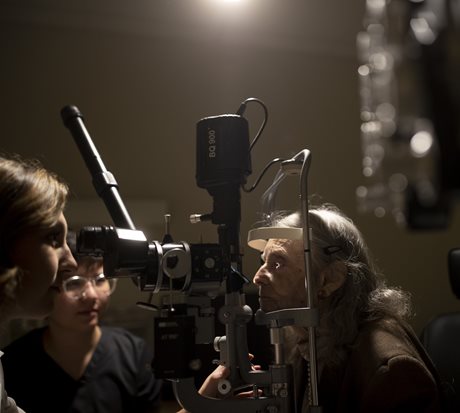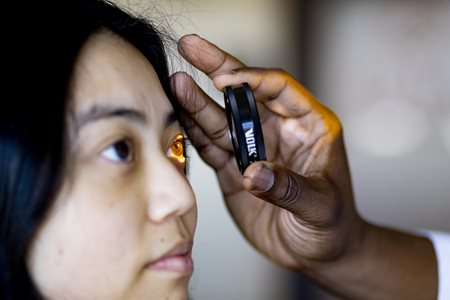What You Need to Know about Diabetes and Your Eyes
Diabetes is the leading cause of vision loss in people 18 to 64 years old, according to the American Diabetes Association. However, 90% of vision loss from diabetes can be prevented. Early detection is key. People with diabetes should schedule annual eye exams even before they have signs of vision loss.
 Diabetes is a disease that affects the body’s ability to produce or use insulin effectively to control blood sugar (glucose) levels. Too much glucose in the blood for a long time can cause damage in many parts of the body. Diabetes can damage the heart, kidneys and blood vessels. It also damages small blood vessels in the eye.
Diabetes is a disease that affects the body’s ability to produce or use insulin effectively to control blood sugar (glucose) levels. Too much glucose in the blood for a long time can cause damage in many parts of the body. Diabetes can damage the heart, kidneys and blood vessels. It also damages small blood vessels in the eye.
Diabetic eye disease refers to the group of eye conditions that can result from diabetes. These include:
Diabetic retinopathy. The leading cause of blindness in American adults, diabetic retinopathy occurs when changes in the retina’s blood vessels cause either leaking of the vessels or growth of abnormal new blood vessels on the retina’s surface. This damage causes symptoms such as blurry vision, floaters and black spots in the field of vision, poor color perception and even blindness.
Macular edema. The macula, the center of the retina that provides sharp, straight vision, can swell due to leaky blood vessels caused by diabetes. This can result in blurred or distorted vision.
Glaucoma. One form of glaucoma, neovascular glaucoma, is caused by diabetes. High sugar levels can damage the retina’s blood vessels and result in the creation of abnormal new ones. When new blood vessels grow on the eye’s iris (the colored part of the eye), it can cause an increase in eye pressure and glaucoma. Onset can be sudden and will present itself with blurriness, eye pain and redness, nighttime halos and headaches.
Cataracts. Cataracts can form earlier and progress faster in people with diabetes due to the increase of sugar in the blood. This creates a cloudy buildup in the eye’s lens, resulting in a cataract. The symptoms are similar to glaucoma and diabetic retinopathy but may also include double vision, light sensitivity and night blindness.
Anyone with diabetes can develop diabetic eye disease. Your risk is greater with high blood glucose or high blood pressure that is not treated. High blood cholesterol and smoking may also raise your risk for diabetic eye disease.
 Some groups are affected more than others. African Americans, American Indians and Alaska Natives, Hispanics/Latinos, Pacific Islanders, and older adults are at greater risk of losing vision or going blind from diabetes.
Some groups are affected more than others. African Americans, American Indians and Alaska Natives, Hispanics/Latinos, Pacific Islanders, and older adults are at greater risk of losing vision or going blind from diabetes.
If you have diabetes and become pregnant, you can develop eye problems very quickly during your pregnancy. If you already have some diabetic retinopathy, it can get worse during pregnancy. Changes that help your body support a growing baby may put stress on the blood vessels in your eyes. Your healthcare team will suggest regular eye exams during pregnancy to catch and treat problems early and protect your vision.
Ways you can help prevent eye problems caused by diabetes include:
- Control your blood sugar. Schedule regular doctor visits for blood sugar monitoring. Listen to your doctors’ recommendations and follow them.
- Control your diet. Eating right is essential when trying to prevent or control diabetes. You need to eat a diet high in nutrients, low in fat and moderate in calories. Although you do not need to eliminate sugar completely, you must limit sugar to a small serving.
- Exercise regularly. Exercise can help you control your blood sugar, increase fitness and reduce your risk for heart disease and nerve damage. You should track your blood sugar before, during and after exercise to prevent hypoglycemia, also called low blood glucose or low blood sugar, which can cause insulin shock.
- Stop smoking. Smoking can cause further damage to your blood vessels, including the ones in your eyes, so it’s very important to stop smoking.
- Avoid harmful rays. Protect yourself from the sun’s harmful ultraviolet rays by wearing sunglasses. Exposure to these rays can speed up the progression of cataracts.
 Have regular, comprehensive eye exams.Your eye doctor will test for diabetic eye diseases during your examinations. If you are pre-diabetic or diabetic, it is even more important to have regular follow-up visits to monitor your vision.
Have regular, comprehensive eye exams.Your eye doctor will test for diabetic eye diseases during your examinations. If you are pre-diabetic or diabetic, it is even more important to have regular follow-up visits to monitor your vision.
Scheduling a comprehensive eye exam at least once a year is an excellent first line of defense against diabetic eye disease, but you should contact your eye doctor sooner if you notice any visual changes. During the exam, an optometrist can check for signs and symptoms of potential problems. To schedule an appointment at The Eye Institute, call 215.276.6111.